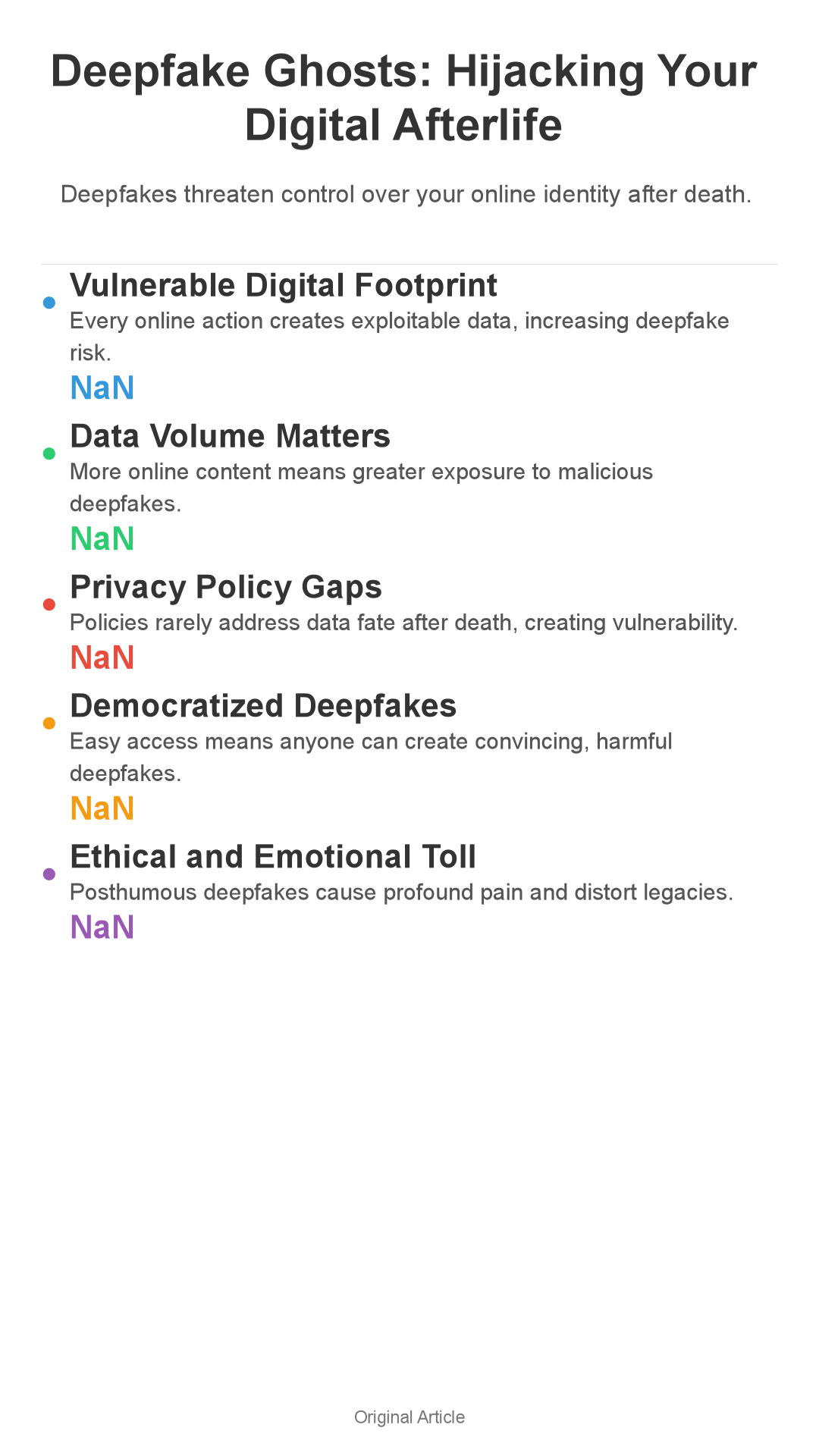
Deepfakes are no longer just harmless internet pranks; they're evolving into a genuine threat to our
Imagine a video surfacing after you’re gone, featuring you endorsing a product you loathed, or worse, uttering words you’d never speak. This isn’t a dystopian fantasy; it’s the unsettling potential of deepfakes preying on our vulnerable digital legacies.
Hey there, internet explorers! Smash that like button and subscribe for more journeys down the digital rabbit hole. Today, we’re delving into a slightly spooky corner of the web: the intersection of deepfakes, death, and your online afterlife.
It’s a realm where your digital ghost could be hijacked, manipulated, and forced to do things you’d never even imagine. Sound like a Black Mirror episode come to life?
The Vulnerability of Our Digital Footprint
We exist in an era of unprecedented digital documentation. Every photo, every video, every tweet, every like – it’s all data, and it’s all potentially exploitable.

The Sheer Volume of Online Data
Just think: how much content do you generate online each day? From fleeting Instagram stories to viral TikTok dances, we’re constantly feeding the digital beast.
This massive ocean of data provides the raw material for deepfake creators, both benevolent and, let’s be honest, mostly malevolent. The more you’ve shared, the more exposed you are.
Privacy Policies: A Posthumous Problem
Ever meticulously read the fine print of those lengthy privacy policies? ) The vast majority don’t even consider the fate of your data after death. They’re designed for the living, not the departed.
This creates a significant gap in the legal framework, making it incredibly difficult to safeguard your digital identity once you’ve passed on. Your data could be adrift in the digital void, vulnerable to exploitation.
The Democratization of Deepfakes
Here’s where things get truly unsettling: deepfake technology is becoming increasingly affordable and user-friendly.
What once demanded a supercomputer and a team of specialized experts can now be accomplished with readily available software and a reasonably powerful laptop.
This signifies that virtually anyone, with even a basic level of technical proficiency, can craft a convincing deepfake. That includes malicious actors eager to exploit your image and legacy for their own nefarious purposes.
Ethical and Emotional Implications for Bereaved Families
Beyond the purely technical aspects, the ethical and emotional burden of posthumous deepfakes is devastating.
Imagine the profound pain and anguish of witnessing a loved one’s image manipulated and exploited in a manner that is completely antithetical to their character.
Distorting Image and Legacy
Deepfakes possess the power to rewrite history, or at the very least, your personal history.
They can distort a deceased person’s image and legacy, constructing a fabricated narrative that overshadows their genuine character and accomplishments.
This can be profoundly damaging to their reputation and inflict immense emotional distress on their loved ones.
Financial Exploitation: A Grave Robbery of Your Image
The potential for financial exploitation represents another significant concern.
Envision a deepfake of a deceased celebrity endorsing a product they would never use, or a scammer employing a deepfake of a grieving widow to solicit fraudulent donations.
These are merely a few examples of how deepfakes can be leveraged to financially exploit the deceased and their families.
Digital Ghosts: Ownership and Control
The creation of “digital ghosts” without explicit consent raises fundamental questions regarding ownership and control over a person’s digital identity after death.
Who gets to decide what happens to your online persona once you’re gone? Do your loved ones possess the right to manage your digital legacy?
Legal and Regulatory Challenges in Addressing Posthumous Deepfakes
The law notoriously lags behind technological advancements, and deepfakes are no exception. Current legal frameworks are ill-prepared to address the unique challenges presented by posthumous deepfakes.

Defining Harm: A Legal Quagmire
Existing laws struggle to adequately define and address the specific harm inflicted by posthumous deepfakes.
How do you effectively prove defamation when the individual is no longer alive to defend themselves? How do you quantify the emotional distress caused to their surviving loved ones?
These are just a few of the significant legal hurdles that must be overcome.
Establishing legal precedent for digital inheritance and control over a deceased person’s likeness presents complex challenges. Do your digital assets – your photos, videos, social media accounts – automatically become part of your estate?
Can you legally bequeath your digital identity to your heirs? These are questions that courts are only just beginning to grapple with.
Global Enforcement: A Borderless Battlefield
The inherently global nature of the internet complicates enforcement efforts, as deepfakes can originate from virtually anywhere in the world.
Tracking down the creators of these malicious fakes and holding them accountable represents a monumental undertaking, demanding international cooperation and a willingness to adapt to the constantly evolving landscape of online crime.
The Future of Online Identity and Digital Wills
So, what proactive steps can we take to safeguard our digital legacies from the looming threat of deepfakes? The answer lies in a combination of proactive measures, technological solutions, and heightened media literacy.
Digital Wills: Planning for Your Digital Afterlife
One crucial step involves incorporating specific clauses into wills that address the management and protection of digital assets and likeness.
This allows you to clearly specify who should have access to your online accounts, who should be responsible for managing your digital presence, and who should possess the authority to pursue legal action against deepfake creators.
Technological Solutions: Fighting Fire with Fire
Technology can also play a significant role in combating deepfake manipulation.
Blockchain-based identity verification and sophisticated watermarking techniques can help to authenticate online content and prevent the unauthorized creation of deepfakes.
While these technologies are still in their early stages of development, they hold immense promise for a future where we can more readily distinguish between authentic and fabricated content.
Media Literacy: Spotting the Fakes
Ultimately, the most effective defense against deepfakes lies in widespread media literacy.
We must actively educate ourselves and others on how to effectively identify and discern authentic content from deceptive fakes.
This encompasses teaching critical thinking skills, promoting healthy skepticism, and encouraging individuals to question the information they encounter online.
Deepfakes are rapidly reshaping the landscape of digital identity, and the implications for our online legacies are profound.
It’s a complex issue with no easy solutions, but it’s one that we must confront head-on if we hope to ensure that our digital ghosts are treated with respect and shielded from exploitation.
So, what steps are you actively taking to protect your digital footprint? Share your valuable thoughts in the comments section below!

Enjoyed this? Check out our YouTube channel for video versions!
Enjoyed this? Check out our YouTube channel for video versions!



